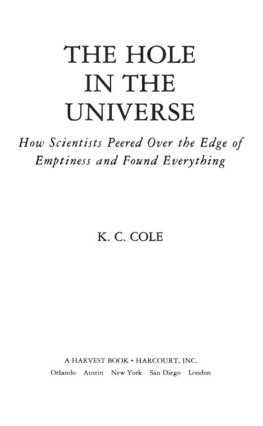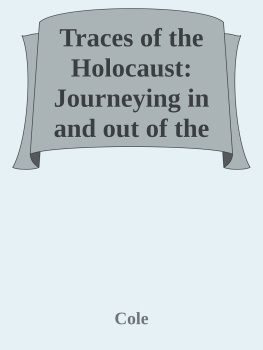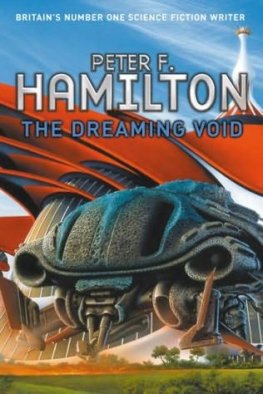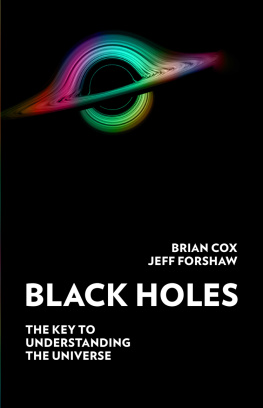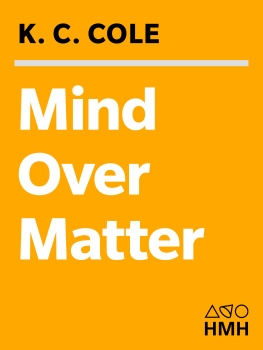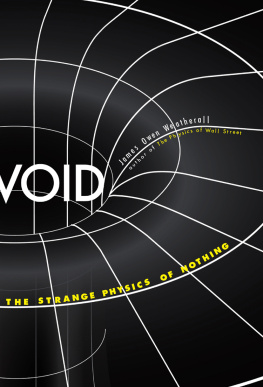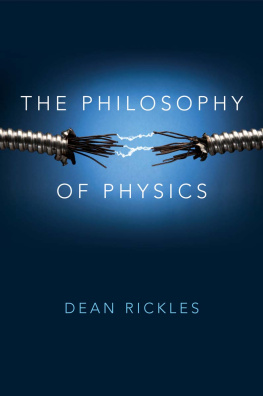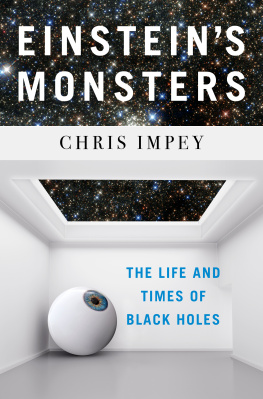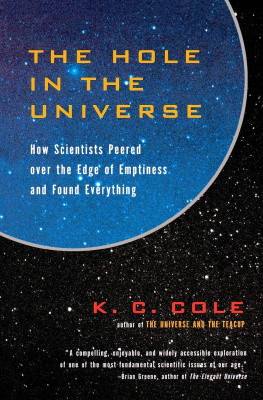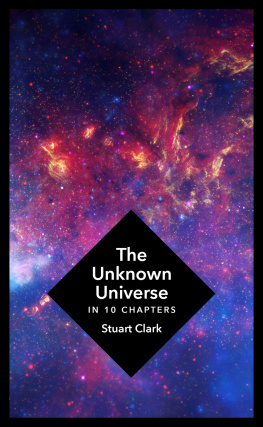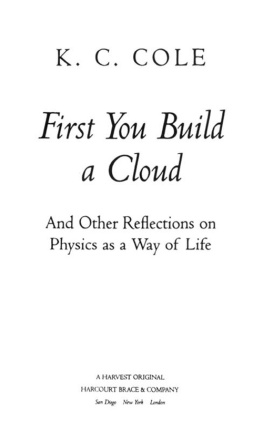Copyright 2001 by K.C. Cole
All rights reserved. No part of this publication may be reproduced or transmitted in any form or by any means, electronic or mechanical, including photocopy, recording, or any information storage and retrieval system, without permission in writing from the publisher.
Requests for permission to make copies of any part of the work should be submitted online at www.harcourt.com/contact or mailed to: Permissions Department,
Houghton Mifflin Harcourt Publishing Company, 6277 Sea Harbor Drive, Orlando, Florida 32887-6777.
www.Harcourt Books.com
Library of Congress Cataloging-in-Publication Data
Cole, K. C.
The hole in the universe: how scientists peered over the edge of emptiness and found everything/by K. C. Cole.--1st ed.
p. cm.
Includes bibliographical references and index.
ISBN 978-0-15-100398-3
ISBN 978-0-15-601317-8 (pbk.)
1. PhysicsPhilosophy. 2. Nothing (Philosophy). I. Title.
QC6.C62 2000
530'.01dc21 00-044947
Illustrations by David Barker
Designed by Lois Stanfield, Light Source Images
Text set in Garamond 3
Printed in the United States of America
First Harvest edition 2001
E G I J H F D
For Liz,
Millennium Girl,
Congratulations
and Love,
Mom
Appreciations, Attributions, and Apologies
Nothing is far and away the most difficult subject I have attempted to pin down on the pages of a book. On the one hand, its so boundless that it refuses to stay put, oozing into everything. On the other hand, it can be so soft and insubstantial that it eludes a hard look. Grasping "nothing requires resisting the temptation to follow it wherever it leads, getting lost in the semantic thicket of nothing puns, or simply bouncing the idea around on ones knee, stringing together curious facts and ancient historytaking it for a pleasurable, if rather pointless, trip.
I have tried to avoid these temptations, and to the extent I have failed, I hope the reader will forgive me. I hope I have managed, after all, to say something about nothing. At the least, I hope to convince the reader that nothing matters. Most of modern physics and mathematics would be unthinkable without it. The human mind we use to perceive and explore those worlds relies on notions of nothing in very tangible wayscreating something out of nothing as handily as it does the reverse.
In one way or another, I have been writing about "nothing for nearly twenty yearsever since I first heard physicists casually tossing about the term vacuum at meetings in a way that made it clear they were talking about a real, palpable, and critically important phenomenon. Since that time, Ive been pursuing the subject as the physical science writer for the Los Angeles Times. I thank the Times for that opportunityespecially my editor, Joel Greenbergand also for leave in which to write the book.
The material for this book was gathered primarily from three broad categories of sources: books and papers, meetings, and interviews. The books and papers are listed in the bibliography and often cited in the text as well. Meetings are also sometimes cited in the text. In cases where no source is cited, readers can assume that direct quotations are based on personal conversations of one kind or another.
I have omitted notes because statements that read as fact" are at the very least the consensus of a wide range of experts. In places where a discovery or a turn of phrase or an idea seems the province of one person more than others, Ive stated that person's name. Where consensus is difficultfor example, in cosmology or string theoryI have tried to indicate whether the ideas discussed are widely accepted, highly tentative, or merely idiosyncratic. In cases where a discovery or idea is attributed to a specific scientist, chances are it was not a solo effort; the reader would probably be safe to automatically add and colleagues after most attributions.
The book covers a great deal of ground in relatively few words and focuses on tracking ideas rather than those who deserve credit for them. In fast-forwarding through important historical periods and intellectual developments, it leaves out a great deal. To make up for these omissions, I have tried to include in the bibliography (and sometimes in the text) what I feel is the best accessible source on the subject at hand. Luckily, there are many excellent accounts: for example, Brian Greene on string theory, Alan Guth on cosmology, Kip Thorne on general relativity.
Most important of all were the many conversations over the years with scientists courageous enough to venture into the void. Some of those are listed in the supporting castalong with other people I cite frequently throughout the book. I would like to thank all of themas well as those I have forgotten to mentionfor their insights and time. I also thank the Mathematical Sciences Research Institute in Berkeley and the Exploratorium in San Francisco for summer fellowships that made much of the research possible. Napoleon Williams gets a special thanks for his continual flow of nothing tidbits and thoughts and for his general enthusiasm for this project.
Some scientists went far beyond mere conversation and also read sections of this book as it was coming to be, offering comments, criticism, and suggestions. Their efforts have vastly improved what follows. In particular, I wish to thank Brian Greene, Rocky Kolb, Haim Harari, Lynn Cominsky, Alan Guth and Richard Brown.
A very special thanks to physicist Thomas Humphreyartist, musician, and master physics teacherfor plowing through the entire manuscript and for many entertaining and enlightening conversations about everything and nothing over the past twenty-five years.
I owe an enormous debt of gratitude to Tom Seigfried, science editor of the Dallas Morning News and author of the charming and important new book, The Bit and the Pendulum: From Quantum Computing to M TheoryThe New Physics of Information. Tom scoured every line of this manuscript and found numerous mistakes and inconsistencies. I don't know anyone else who manages to combine such a fierce commitment to accuracy with such a fine clarity of expression. Speaking of sticklers, many thanks to my patient and thorough and good-humored copy editor, Rachel Myers.
Susan Chace and Patty OToolesuperb writers and esteemed colleagues in all thingsoffered early and critical advice, direction and support.
As always, I relied enormously on my friends and family, my agent Ginger Barber, my courageous colleagues at JAWS (Journalism and Women Symposium) and PEN Center USA West.
I wish to acknowledge the inspiration of my Spring 2000 Concepts of Nothing Honors Collegium students at UCLA, and especially Jordan Richmond, from whom I stole the idea of a hole in the heart that opens the book. I thank Stan Wojcicki for pointing me to the story from Richard Feynman that closes the book. Finally, a big thanks to David Barker for the inspired illustrations.
The inspiration for the book came from Jane I say, my editor, publisher, and biggest fan, who asked me if Id like to write a book about a number. Zero came immediately to mind. Nothing followed. Thanks for nothing, Jane.
Chapter 1
WHY NOT? A PRELUDE
Nothing is too wonderful to be true.
M ICHAEL F ARADAY
T HERE IS A HOLE in the universe.
It is not like a hole in a wall where a mouse slips through, solid and crisp and leading from somewhere to someplace. It is rather like a hole in the heart, an amorphous and edgeless void. It is a heartfelt absence, a blank space where something is missing, a large and obvious blind spot in our understanding of the universe.
That missing something, strange to say, is a grasp of nothing itself. Understanding nothing matters, because nothing is the allimportant background upon which everything else happens. Without it, the universe is theater without a stage. Without getting to know it, we cant understand the blank page on which the story of everything is written. We cant trust our own perceptions because everything we see passes through it like a clear but distorting lens, like light from the sky skidding over hot pavement to create a shimmering mirage.
Next page
